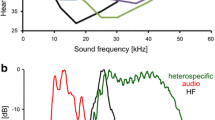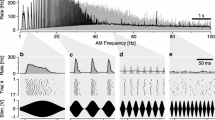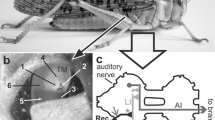Abstract
Many acoustically communicating grasshoppers live in crowded populations where sound of many individuals may cause permanent noise. Tympanic receptors and first-order auditory interneurons of Locusta migratoria code such noise tonically, whereas many higher order interneurons react only weakly. In response to simultaneously presented sound they exhibit a better signal-to-noise ratio than their presynaptic elements. Two possible filter mechanisms are suggested for noise reduction in higher-order interneurons: (i) high-pass filtering of receptor spike frequencies and (ii) filtering due to synchronization of receptor spikes. Different receptor spike frequencies were elicited by series of short noise pulses with variable repetition rates. Receptor activities differing in their degree of synchronization were elicited by sound stimuli with variable rising times. In contrast to the first order interneurons some higher order interneurons responded best to receptor spike frequencies above 150–200 Hz, thus showing the postulated filtering. Only one higher order interneuron (AN4) distinguished between synchronous and asynchronous receptor activities. It is suggested that high-pass filtering of receptor spike frequencies is responsible for the noise filtering observed in these interneurons. The synchronization selectivity of AN4 is proposed to be responsible for temporal pattern detection of conspecific sounds.
Similar content being viewed by others
References
Adam L-J (1977) The oscillating summed action potential of an insect's auditory nerve (Locusta migratoria, Acrididae). II. Underlying spike pattern and causes of spike synchronisation. Biol Cybernetics 28: 109–119
Boyan GS, Fullard JH (1988) Information processing at a central synapse suggests a noise filter in the auditory pathway of the noctuid moth. J Comp Physiol A 164: 251–258
Gilbert F, Elsner N (1995) Directional hearing of the grasshopper Chorthippus biguttulus (L.) in natural habitats. I. Behavioural studies. In: Elsner N, Menzel R (eds) Göttingen neurobiology report. Proceedings of the 23rd Göttingen Neurobiology Conference: 276
Hedwig B (1989) Modulation of auditory information processing in tethered flying locusts. J Comp Physiol A 164: 409–422
Hedwig B, Knepper M (1992) NEUROLAB, a comprehensive program for the analysis of neurophysiological and behavioural data. J Neurosci Methods 45: 135–148
Hedwig B, Meyer J (1994) Auditory information processing in stridulating grasshoppers: tympanic membrane vibrations and neurophysiology. J Comp Physiol A 174: 121–131
Helversen D von (1972) Gesang des Männchens und Lautschema des Weibchens bei der Feldheuschrecke Chorthippus biguttulus (Orthoptera, Acrididae). J Comp Physiol 81: 381–422
Helversen D von (1984) Parallel processing in auditory pattern recognition and directional analysis by the grasshopper Chorthippus biguttulus L. (Acrididae). J Comp Physiol 154: 837–846
Helversen D von (1993) ‘Absolute steepness’ of ramps as an essential cue for auditory pattern recognition by a grasshopper (Orthoptera; Acrididae; Chorthippus biyuttulus L.). J Comp Physiol A 172: 633–639
Helversen O von, Helversen D von (1987) Innate receiver mechanisms in the acoustic communication of orthopteran insects. In: Guthrie DM (ed) Aims and methods in neuroethology. Manchester University Press, pp 104–150
Helversen D von, Helversen O von (submitted) Recognition of sex in the acoustic communication of the grasshopper Chorthippus biguttulus (Orthoptera, Acrididae)
Jacobs W (1953) Verhaltensbiologische Studien an Feldheuschrecken. Beiheft l zur Zeitschrift fuer Tierpsychologie Parey Berlin Hamburg, pp 1–228
Krahe R, Ronacher B (1993) Long rise times of sound pulses in grasshopper songs improve the directionality cues received by the CNS fron the auditory receptors. J Comp Physiol A 173: 425–434
Lang F, Elsner N (1989) The interference of sound and movement stimuli in auditory interneurons of Locusta migratoria L. J Comp Physiol A 164: 697–706
Lang F, Elsner N (1994) Leg movement and hearing: biophysics and electrophysiology of the tympanal organ in Locusta migratoria. J Comp Physiol A 175: 251–260
Lang F, Brandt G, Glahe M (1993) A versatile multichannel acoustic stimulator controlled by a personal computer. Elsner N, Heisenberg M (eds) Gene-brain-behaviour. Proc 21st Neurobiol Conf, pp 892
Marquart V (1985) Auditorische Interneurone im thorakalen Nervensystem von Heuschrecken: Morphologie, Physiologie und synaptische Verbindungen. Dissertation Universitaet Bochum, pp 1–100
Meyer J (1994) Möglichkeiten und Grenzen der Anpassung des Gehörs an die Erfordernisse der innerartlichen Kommunikation bei Feldheuschrecken. Eine biophysikalische, elektrophysiologische und verhaltensbiologische Studie. Dissertation Universität Göttingen
Meyer J, Elsner N (1995) How respiration affects auditory sensitivity in the grasshopper Chorthippus biguttulus (L.). J Comp Physiol A 176: 563–573
Michelsen A (1978) Sound reception in different environment. Ali MA (ed) Perspectives in sensory ecology. Plenum Press, New York London, pp 354–373
Michelsen A (1994) Directional hearing in crickets and other small insects. In: Schildberger K, Elsner N (eds) Neural basis of behavioural adaptations. Fortschritte der Zoologie 39:195–208
Michelsen A, Rohrseitz K (1995) Directional sound processing and interaural sound transmission in a small and a large grasshopper. J Exp Biol 198: 817–1827
Pearson KG, Boyan GS, Bastiani M, Goodman CS (1985) Heterogeneous properties of segmentally homologous interneurons in the ventral nerve cord of locusts. J Comp Neurology 233: 133–145
Pollack GS (1988) Selective attention in an insect auditory neuron. J Neuroscience 8: 2635–2639
Rheinlaender J, Römer H (1986) Insect hearing in the field I. The use of identified nerve cells as ‘biological microphones’. J Comp Physiol A 158: 647–651
Robert D (1989) The auditory behaviour of flying locusts. J Exp Biol 147: 279–301
Römer H (1976) Die Informationsverarbeitung tympanaler Rezeptorelemente von Locusta migratoria (Acrididae, Orthoptera). J Comp Physiol 109: 101–122
Römer H (1994) Bushcricket acoustic communication: role of transmission channel and receiver psychology. In: Schildberger K, Elsner N (eds) Neural basis of behavioural adaptations. Fortschritte der Zoologie 39: 243–252
Römer H, Marquart V (1984) Morphology and physiology of auditory interneurons in the metathoracic ganglion of the locust. J Comp Physiol A 155: 249–262
Römer H, Seikowski U (1985) Responses to model songs of auditory neurons in the thoracic ganglia and brain of the locust. J Comp Physiol 156: 845–860
Römer H, Bailey W, Dadour I (1989) Insect hearing in the field: III. Masking by noise. J Comp Physiol A 164: 609–620
Ronacher B, Römer H (1985) Spike synchronisation of tympanic receptor fibres in a grasshopper (Chorthippus biguttulus L., Acrididae). J Comp Physiol A 157: 631–642
Ronacher B, Stumpner A (1988) Filtering of behaviourally relevant temporal parameters of a grasshopper's song by an auditory interneuron. J Comp Physiol A 163: 517–523
Sobel EC, Tank DW (1994) In Vivo Ca2+ dynamics in a cricket auditory neuron: an example of chemical computation. Science 263: 823–826
Sprouston N, Jaffe DB, Johnston D (1994) Dendritic attenuation of synaptic potentials and currents: the role of passive membrane properties. TINS 17: 161–166
Stumpner A (1988) Auditorische thorakale Interneurone von Chorthippus biguttulus L.: Morphologische und physiologische Charakterisierung und Darstellung ihrer Filtereigenschaften fuer verhaltensrelevante Lautattrappen. Dissertation Univ. Erlangen, pp 1–214
Stumpner A (1989) Physiological variability of auditory neurons in a grasshopper: comparison of twin cells and mirror-image cells. Naturwiss 76: 427–429
Stumpner A, Ronacher B (1991) Auditory interneurones in the metathoracic ganglion of the grasshopper Chorthippus biguttulus. I. Morphological and physiological characterization. J Exp Biol 158: 391–410
Stumpner A, Ronacher B, Helversen O von (1991) Auditory interneurones in the metathoracic ganglion of the grasshopper Chorthippus biguttulus. II. Processing of temporal patterns of the song of the male. J Exp Biol 158: 411–430
Werner A, Elsner N (1995) Directional hearing in the grasshopper Chorthippus biguttulus (L.) in natural habitats. II. A biological microphone. In. Elsner N, Menzel R (eds) Göttingen neurobiology report 1995. Proceedings of the 23rd Göttingen Neurobiology Conference 2: 277
Wohler D, Huber F (1982) Processing of sound signals by six types of neurons in the prothoracic ganglion of the cricket, Gryllus campestris L.. J Comp Physiol A 146: 161–173
Author information
Authors and Affiliations
Rights and permissions
About this article
Cite this article
Lang, F. Noise filtering in the auditory system of Locusta migratoria L. J Comp Physiol A 179, 575–585 (1996). https://doi.org/10.1007/BF00192323
Accepted:
Issue Date:
DOI: https://doi.org/10.1007/BF00192323




